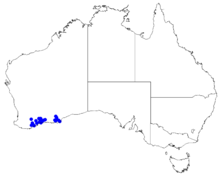Boronia inconspicua
Boronia inconspicua is a plant in the citrus family, Rutaceae and is endemic to the south-west of Western Australia. It is a shrub with pinnate leaves and small white or creamy green flowers with four petals and eight stamens and occurs from the Stirling Range to Mount Ragged.
| Boronia inconspicua | |
|---|---|
| Scientific classification | |
| Kingdom: | Plantae |
| Clade: | Tracheophytes |
| Clade: | Angiosperms |
| Clade: | Eudicots |
| Clade: | Rosids |
| Order: | Sapindales |
| Family: | Rutaceae |
| Genus: | Boronia |
| Species: | B. inconspicua |
| Binomial name | |
| Boronia inconspicua | |
 | |
| Occurrence data from Australasian Virtual Herbarium | |
Description
Boronia inconspicua is an erect, spreading or rounded, compact shrub that grows to a height of 1 m (3 ft) with its branches hairless or with a few soft hairs. The leaves are pinnate with three, five or seven leathery, narrow oblong to narrow wedge-shaped leaflets 3–10 mm (0.1–0.4 in) long. The flowers are borne singly or in cymes of a few flowers, the flowers on a glabrous pedicel 2–4 mm (0.08–0.2 in) long. The four sepals are triangular, leathery and about 0.6 mm (0.024 in) long. The petals are white to creamy green, about 1.5 mm (0.059 in) long with pimply glands. The eight stamens have a few hairs and the stigma is small. Flowering mainly occurs from September to December.[2][3]
Taxonomy and naming
Boronia inconspicua was first formally described in 1863 by George Bentham from a specimen collected by James Drummond and the description was published in Flora Australiensis.[4][5] The specific epithet (inconspicua) is Latin word meaning "not readily visible" or "not prominent".[6]
Distribution and habitat
This boronia usually grows on rocky outcrops and is found from the Stirling Range to Mount Ragged in the Esperance Plains and Mallee biogeographic regions.[2][3]
Conservation
Boronia inconspicua is classified as "not threatened" by the Western Australian Government Department of Parks and Wildlife.[3]
References
- "Boronia inconspicua". Australian Plant Census. Retrieved 20 March 2019.
- Duretto, Marco F.; Wilson, Paul G.; Ladiges, Pauline Y. "Boronia inconspicua". Australian Biological Resources Study, Department of the Environment and Energy, Canberra. Retrieved 20 March 2019.
- "Boronia inconspicua". FloraBase. Western Australian Government Department of Parks and Wildlife.
- "Boronia inconspicua". APNI. Retrieved 20 March 2019.
- Bentham, George; von Mueller, Ferdinand (1863). Flora Australiensis. London: Lovell Reeve & Co. p. 313. Retrieved 20 March 2019.
- Brown, Roland Wilbur (1956). The Composition of Scientific Words. Washington, D.C.: Smithsonian Institution Press. p. 436.
